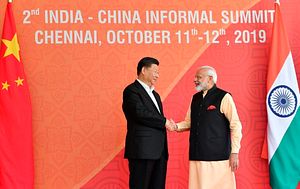The recent meeting between Indian Prime Minister Narendra Modi and Chinese President Xi Jinping in the southern Indian city of Mamallapuram was meant to provide a forum for the leaders to build on the progress they had purportedly made in the central Chinese city of Wuhan in 2018, their first “informal summit.”
In theory, an informal summit setting has value. It allows the two leaders to get to know one another. Modi, leader of the world’s largest democracy with a political mandate unseen in more than three decades, and Xi, effectively China’s leader for life if he chooses, stand to be significant figures when the history of Asian geopolitics in the first half of the 21st century is written.
Candid exchanges between the two, therefore, are meant to pave the way for progress. However, there’s little indication that this sort of progress is really under way as part of the Wuhan-Mamallapuram process.
Xi and Modi may have grown used to sharing the stage for photo opportunities on each other’s soil, but the geopolitical issues that divide India and China remain
To keep the mood positive in Mamallapuram, neither pressed on raw nerves. On the Indian side, these include the recent decision by the government to abrogate parts of article 370 of the constitution, changing the internal administrative status of northern Jammu and Kashmir state.
For China, complaints about “core interests” – including the protests in Hong Kong, freedom of navigation in the South China Sea, and even atrocities in western Xinjiang Uygur autonomous region – were omitted.
China claims the entirety of the Indian state of Arunachal Pradesh as “South Tibet,” and India claims China-occupied Aksai Chin as part of its territory. These issues have been part of talks for years, but a final, comprehensive settlement remains distant, even after 2017 when the armed forces of the two countries went eyeball-to-eyeball along the border.
Beyond this, issues new and old – from India’s continued accommodation of the Dalai Lama to China’s “all-weather” relationship with Pakistan – continue to dog their ties. But despite these differences, India and China have largely been able to maintain a relationship that waxes and wanes between cooperative and competitive bouts.
If appearances at Mamallapuram are to be believed, the relationship continues in its post-Wuhan summit “reset.” However, look closer and the geopolitical unease between India and China bubbles to the surface.
According to Xinhua’s view of the meeting, China emphasized the need for both sides to “correctly view each other’s development and enhance strategic mutual trust.”
The message? Neither side should allow external influences to affect their relationship. This summit, of course, came just weeks after the first foreign minister-level meeting of the reconvened “quadrilateral” involving the United States, India, Japan and Australia on the sidelines of the United Nations General Assembly in New York. Neither China nor India has forgotten about the broader tensions underlying their relationship.
As if to underscore these concerns, Xi followed up his trip to India with a visit to Nepal, where he became the first Chinese leader to set foot in the country since Jiang Zemin in 1996.
In Kathmandu, Xi elevated the relationship between the two countries and was likely to have marked what will someday be seen as a watershed moment in Nepal’s geopolitical drift out of India’s orbit, where it had lingered for decades.
The Modi government has its foreign policy tastes and predilections, but India’s primary grand strategic goal remains its own economic uplifting. Even as relations with China remain difficult – and are likely to become more so in the years ahead – it will be difficult for New Delhi to totally and decisively pivot away from its neighbour to the north.
And so, at Mamallapuram, it was economic issues that were the easiest to discuss and announce: rebalancing trade, encouraging mutual investors, and deepening economic cooperation. For India, in particular, slowing economic indicators make China’s salience as a neighbour and investor all the more important.
The story of India and China in the near term will be more of the same. The competitive dynamic will persist but its effects will be managed before they can spiral out of control.
The informal summits – an Indian idea – may have their place as long as Xi and Modi sit in control in Beijing and Delhi but their effect will be far from transformative. Another such meeting will take place next year in China.
For now, India and China remain as far apart as ever on the fundamentals. And given their interests and mutual suspicions, no amount of meetings can change that.
This article first appeared in the South China Morning Post. It is republished here with kind permission.

































